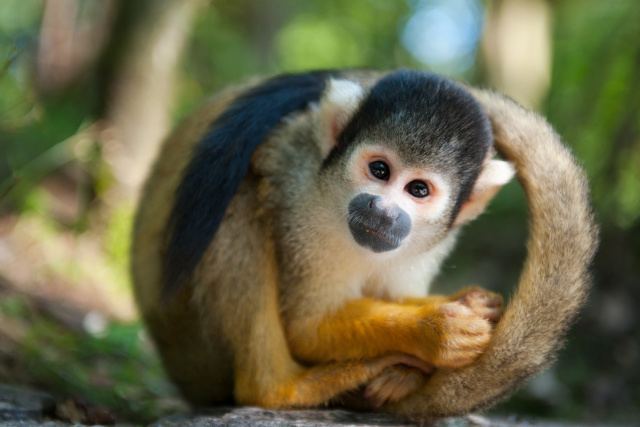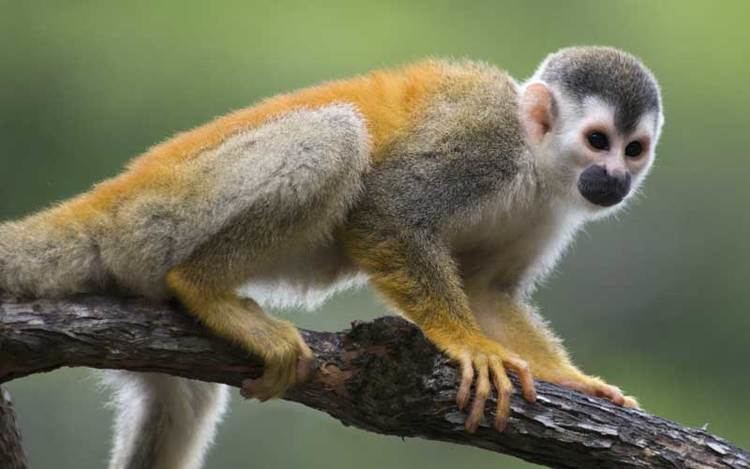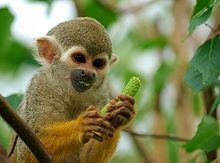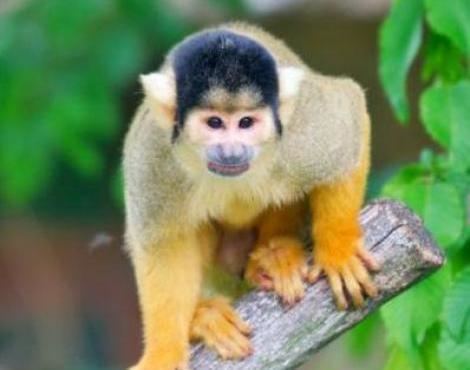Scientific name Saimiri Rank Genus | Phylum Chordata Higher classification Cebidae | |
 | ||
Subfamily SaimiriinaeMiller, 1912 (1900) Lower classifications Common squirrel monkey, Black‑capped squirrel monkey, Central American squirrel m, Black squirrel monkey, Bare‑eared squirrel monkey | ||
Jell o enrichment for squirrel monkeys at the bronx zoo
Squirrel monkeys are New World monkeys of the genus Saimiri. They are the only genus in the subfamily Saimirinae. The name of the genus is of Tupi origin (sai-mirim or gai-mbirin < sai 'monkey' and mirim 'small'), and was also used as an English name by early researchers.
Contents
- Jell o enrichment for squirrel monkeys at the bronx zoo
- Taxonomy
- Evolution
- Description
- Behaviour and ecology
- Color vision
- References

Squirrel monkeys live in the tropical forests of Central and South America in the canopy layer. Most species have parapatric or allopatric ranges in the Amazon, while S. oerstedii is found disjunctly in Costa Rica and Panama.

The common squirrel monkey is captured for the pet trade and for medical research but it is not threatened. Two squirrel monkey species are threatened: the Central American squirrel monkey and the black squirrel monkey are listed as vulnerable by the IUCN.

Taxonomy

Until 1984, all South American squirrel monkeys were considered part of a single widespread species, and many zoologists considered the Central American squirrel monkey to be a member of that single species as well. The two main groups currently recognized can be separated by the white above the eyes; it is shaped as a Gothic ("pointed") Arch in the S. sciureus group, while it is shaped as a Roman ("rounded") Arch in the S. boliviensis group.

Evolution
The crown lineage of the extant squirrel monkeys appears to have diverged around 1.5 million years ago. S. boliviensis appears to be the first diverging species in the group. S. oerstedii and S. s. sciureus, are sister species. S. s. macrodon is the sister species to the S. oerstedii / S. s. sciureus clade.
Description
Squirrel monkey fur is short and close, colored black at the shoulders and yellowish orange on its back and extremities. Their throat and ears are white, and their mouths are black. The upper part of their head is hairy. This black-and-white face gives them the name "death's head monkey" in several Germanic languages (e.g., German Totenkopfaffen, Swedish dödskalleapor, Dutch doodshoofdaapjes) and Slovenian (smrtoglavka).
Squirrel monkeys grow from 25 to 35 cm long, plus a 35 to 42 cm tail. Male squirrel monkeys weigh 750 to 1100 g. Females weigh 500 to 750 g. Both male and females are equipped with a long and hairy tail, flat nail, pointed claws.
Female squirrel monkeys have a pseudo-penis, which they use to display dominance over smaller monkeys, in much the same way that the male squirrel monkeys display their dominance.
Behaviour and ecology
Like most of their New World monkey relatives, squirrel monkeys are diurnal and arboreal. Unlike other New World monkeys, their tail is not used for climbing but as a kind of "balancing pole" and also as a tool. Their movements in the branches can be very rapid.
Squirrel monkeys live together in multi-male/multi-female groups with up to 500 members. These large groups, however, can occasionally break into smaller troops. The groups have a number of vocal calls, including warning sounds to protect the group from large falcons, which are a natural threat. Their small body size also makes them susceptible to predators such as snakes and felids. For marking territory, squirrel monkeys rub their tail and their skin with their own urine.
Squirrel monkeys are omnivores, eating primarily fruits and insects. Occasionally, they also eat seeds, leaves, flowers, buds, nuts, and eggs.
Squirrel monkey mating is subject to seasonal influences. Females give birth to young during the rainy season, after a 150- to 170-day gestation. Only the mothers care for the young. Saimiri oerstedti are weaned by 4 months of age, while S. boliviensis are not fully weaned until 18 months old. Female squirrel monkeys reach sexual maturity at age 2–2.5 years, while males take until age 3.5–4 years. They live to about fifteen years old in the wild, and over twenty years in captivity. Menopause in females probably occurs in the mid-teens.
Color vision
Color vision in squirrel monkeys has been extensively studied as a stand-in for human ailments. In humans, two genes for color vision are found on the X chromosome. Typically, one gene (OPN1LW) produces a pigment that is most sensitive to the 564 nm wavelength, while the other gene (OPN1MW) produces a pigment most sensitive to 534 nm. In squirrel monkeys, there is only one gene on the X chromosome but it exists in three varieties: one is most sensitive to 538 nm, one to 551 nm, and one to 561 nm. Since males have only one X chromosome, they are dichromatic, although with different sensitivities. Females, on the other hand, have two X chromosomes, so some of them can have copies of two different alleles. The three alleles seem to be equally common, leading to one-third of females being dichromatic, while two-thirds are trichromatic. Recently, gene therapy has given the human OPN1LW gene to adult male squirrel monkeys, producing behavior consistent with trichromatic color vision.
